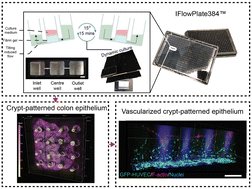A vascularized crypt-patterned colon model for high-throughput drug screening and disease modelling†
Abstract
The colon serves as a primary target for pharmaceutical compound screening and disease modelling. To better study colon diseases and develop treatments, engineered in vitro models with colon-specific physiological features are required. Existing colon models lack integration of colonic crypt structures with underlying perfusable vasculature, where vascular–epithelial crosstalk is affected by disease progression. We present a colon epithelium barrier model with vascularized crypts that recapitulates relevant cytokine gradients in both healthy and inflammatory conditions. Using our previously published IFlowPlate384 platform, we initially imprinted crypt topography and populated the patterned scaffold with colon cells. Proliferative colon cells spontaneously localized to the crypt niche and differentiated into epithelial barriers with a tight brush border. Toxicity of the colon cancer drug, capecitabine, was tested and showed a dose-dependent response and recovery from crypt-patterned colon epithelium exclusively. Perfusable microvasculature was then incorporated around the colon crypts followed by treatment with pro-inflammatory TNFα and IFNγ cytokines to simulate inflammatory bowel disease (IBD)-like conditions. We observed in vivo-like stromal basal-to-apical cytokine gradients in tissues with vascularized crypts and gradient reversals upon inflammation. Taken together, we demonstrated crypt topography integrated with underlying perfusable microvasculature has significant value for emulating colon physiology and in advanced disease modelling.



 Please wait while we load your content...
Please wait while we load your content...